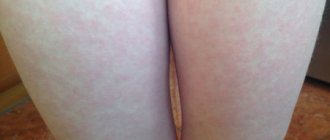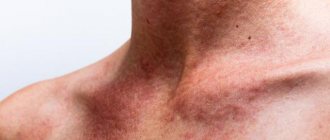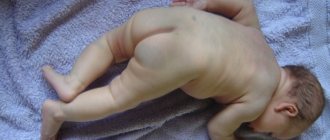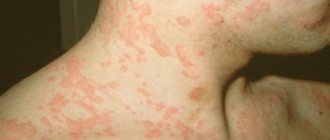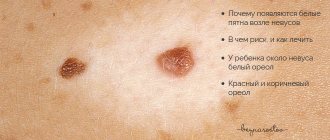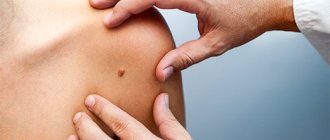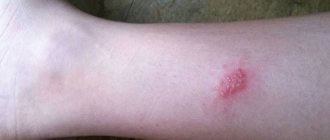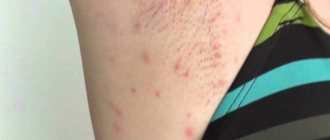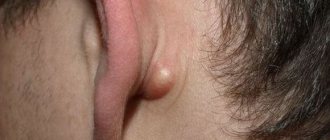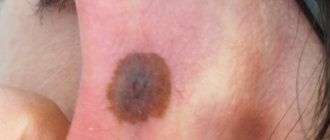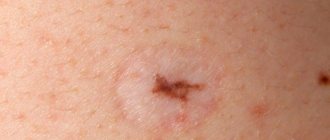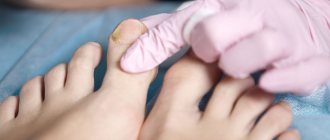Reasons for appearance
Article navigation
A spot on the skin is an area where the natural coloring has been changed. They come in different sizes, shapes and colors. Some spots appear above the surface of the skin, others are formed by burst blood vessels inside. These properties are important for dermatologists and help make the correct diagnosis.
Based on the mechanism of occurrence, the following types are distinguished:
- Vascular - formed as a result of subcutaneous hemorrhage, which externally looks like a spot.
- Pigmentation – occurs when there is an imbalance of melanin in the body. Moles are an example of age spots.
- Infectious – caused by the active growth of pathogenic flora on the skin.
There are also more rare factors that provoke the appearance of spots:
- Xeroderma pigmentosum. It is characterized by brown, scaly growths on the skin. The disease is considered a precancerous condition.
- Melanosis. Unreasonable excess accumulation of pigment in some areas of the body.
- Mastocytosis. A genetic disease in which abnormal cells appear in the blood.
Below are the types of spots that most often appear on the skin.
Reds
The crimson-red color and its shades (blue, pink, purple) are caused by hemorrhages as a result of burst blood vessels. Red spots on the shins and thighs appear with varicose veins, as well as vasodilation caused by other reasons. They are divided into the following types:
- Hyperemic . They can be inflammatory or non-inflammatory in nature. In the first case, inflammation of the venous walls leads to dilation of the vessel and its filling with blood, which looks like a mark. Such spots are called erythema or roseola. With a non-inflammatory etiology, excess blood accumulation can be caused by stress or anxiety. A typical example of such redness in a person occurs when feeling shame.
- Hemorrhagic . Due to the increased permeability of the venous wall, blood enters the tissue and becomes visible through the skin. Hemorrhages occur due to contusions (bruises) or due to vascular diseases.
- Telangiectasia . The cause is a violation of the elasticity of blood vessels and their persistent expansion. Pathology can be caused by congenital characteristics, diseases of the gastrointestinal tract, bad habits, and excessive exposure to ultraviolet radiation.
Red spots with varicose veins
Varicose veins develop gradually and at the first stage can be asymptomatic. After a while, a person begins to feel heaviness in the lower extremities and fatigue at the end of the working day. Later, impaired blood flow leads to problems in small vessels, and then to pronounced changes in the deep veins.
Spots on the legs with varicose veins usually appear on the lower leg or foot - it is in these areas that the load on the vessels is maximum. In addition to their characteristic location, venous spots differ in color, which varies depending on the stage of the disease.
Red spots are the most common manifestation of the first stage of varicose veins. The walls of small vessels become thinner and burst due to increased physical activity or emotional stress. First, small spots appear in the form of dots, and later the well-known spider veins appear.
As the disease progresses and persistent varicose veins appear, the redness on the leg takes on a purple hue. At this stage, serious congestion occurs, in which blood circulation and tissue trophism are impaired. Lack of nutrients and oxygen leads to the formation of trophic ulcers. Red-purple wounds on the leg that do not heal for a long time are the main sign of such a complication (photo below). This stage requires urgent treatment, which is often only possible through surgery. With tissue necrosis, the affected area may acquire a brown tint.
Red spots on a child's legs
Red spots in a baby or school-age child are often a sign of allergies. In newborns, the skin may react to fabric dyes, low-quality toys or food. Varicose veins in children occur only as a congenital pathology. It is not recommended for parents to guess the cause of the spots; it is better to immediately contact a pediatrician.
Lichen
Ringworm is an infectious disease that can be caused by various pathogens (fungi, viruses, bacteria). Pathology has several varieties, which are characterized by a certain appearance of the spots:
- Pityriasis rosea is a round pink lesion that is flaky and surrounded by a red border.
- Shingles - the spots consist of a small blistering rash located along the nerve endings on the body.
- White – white markings without clear boundaries.
- Pityriasis - yellow or brown formations covered with a crust.
- Flat - small nodules of inflammation unite into large spotty foci.
- Ringworm - appears on the head in the form of bald patches.
Lichen spots are always accompanied by itching, pain and other unpleasant sensations. Constant skin problems over time cause a disturbance in the general condition - irritability, decreased immunity, poor sleep.
Light
They belong to pigment spots and occur due to a lack of melanin.
The affected areas can vary in size and shape, but are always lighter than the rest of the skin.
A red spot appears on the leg, it is flaky and itchy, how to treat it
If you notice that a red spot has appeared on your leg that is flaking and itchy, it is important to know how to treat it. The appearance of red spots on the surface of the skin process may indicate the development of an unpleasant process.
They often occur in various dermatological pathologies. The rash may appear as small dots or spots with ill-defined boundaries. If these formations appear, you should not hesitate; it is better to immediately visit a specialist.
The main thing is not to hesitate, otherwise serious problems and health complications may develop.
Causes of peeling and red spots on the legs
Before you start treating peeling and red spots on your legs, you should find out the main reasons for their occurrence. This is what will allow you to choose the right and effective treatment therapy. They can be provoked by various factors and diseases, so it is important to immediately visit a doctor for an examination when they appear.
It is worth noting! Depending on the reasons, the spots on the legs may have some differences. If it worsens, in addition to peeling, other unpleasant symptoms may appear - severe itching, pain, burning.
The main factors causing rashes on the legs include:
- Allergy. If the red spots on your legs are itchy and flaky, this could be the result of a severe allergic reaction. They can be observed upon contact with a specific allergen;
- Atopic dermatitis. Swollen, flaky lumps without a clear outline appear on the skin;
- Formations with a fungal nature. Red spots appear on the feet and fingers. They itch a lot, and in advanced cases begin to peel off;
- Varicose veins Red or bluish spots that resemble stars appear on the surface of the shins;
- Vasculitis. With this disease, small red rashes with severe swelling of the extremities are observed;
- Eczema. Not only red and scaly spots appear, nodules, scaly plaques, and painful blisters are also noted;
- Psoriasis. Plaques with a pink color and a red rim appear; they accumulate in the folds of the skin;
- Red spots, ulcers with peeling and inflammation appear with thermal burns, bruises and frostbite;
- The appearance of rashes and peeling with a red tint may indicate a lack of vitamins in the body.
These are the main reasons that often cause the appearance of red spots with peeling on the legs. They are quite dangerous and require timely treatment. Rashes often occur when the functioning of the kidneys, liver, gallbladder and digestive organs is impaired.
When to see a doctor
If spots with a red tint appear on your legs, which are accompanied by peeling, severe itching, burning, and pain, you should immediately consult a doctor. Do not delay, it is better to visit a specialist at an early stage, otherwise dangerous health problems may arise.
When reddish spots increase greatly, you should not think that this is a temporary phenomenon. In most cases, this may be a consequence of the development of a dangerous disease. During the examination, the doctor must pay attention to the nature of the rash, size and quantity.
The best remedies for flaking, red spots and itching
When red spots and peeling appear on the surface of the limbs, you should immediately begin treatment. But only a doctor can prescribe an effective and most suitable remedy. He makes a preliminary diagnosis and establishes the main cause that caused the rash.
What can you buy at the pharmacy?
Before prescribing a suitable drug, an examination is carried out. It helps to identify the disease or condition that caused the red spots with peeling and other unpleasant symptoms.
Important! Under no circumstances should you start using medications on your own. You should definitely consult your doctor first. If the medication is chosen incorrectly, serious health problems can arise.
Depending on the diagnosis, drugs from different groups can be used:
- Antihistamine type. These medications are prescribed in the presence of allergic reactions. The most effective include “Fenistil”, “Suprastin”, “Zodak”, “Citrine”;
- Antimiconics. Medicines included in this group are used to treat fungal diseases. Fluconazole, Nystatin, Clotrimazole have a good effect;
- Sorbents. The drugs help cleanse the body of toxins and waste that provoke allergic reactions. Among the effective sorbents are Enterosgel, activated carbon;
- Anti-inflammatory drugs. Often with rashes there is a feeling of burning, itching, pain, severe irritation, swelling, and inflammation. The use of such products as Zinc ointment, Irikar, Bepanten help eliminate unpleasant phenomena;
- Hormonal medications. Drugs such as Hydrocortisone ointment, Advantan, and Flucinar help eliminate red spots in psoriasis, eczema, and severe dermatitis.
Rashes often form when the immune system is weakened and vitamin deficiency occurs. In these situations, vitamin complexes are prescribed - “Alphabet”, “Vitrum”, “Complivit”, “Elevit Pronatal” and others.
Home Recipes
Homemade remedies are recommended to be used as an addition to primary medical therapy. They will help quickly eliminate unpleasant symptoms and speed up the recovery process.
The most effective folk remedies include:
- Pickle from sauerkraut. It is recommended to lubricate stains that appear due to allergies with liquid;
- For severe redness, you should use a decoction of oak bark. Pour 1 large spoon of the plant into a bowl and pour a glass of boiling water. It takes about 20-30 minutes to insist. Areas with stains are treated with a decoction;
- If the redness is very itchy and flaky, then you can use raw potatoes. To do this, rub it through a fine grater. The mixture is applied to areas with rashes as a compress for 15 minutes.
Note! To alleviate the condition and eliminate severe itching, you can take baths with medicinal plants - chamomile, celandine, birch leaves and buds. They will speed up the process of eliminating all unpleasant rashes.
Symptoms
Red spots on the legs that appear as a result of varicose veins are not the only symptom. Additionally, a person may be concerned about:
- itching;
- soreness;
- compaction and swelling;
- dryness and flaking;
- decreased performance;
- heaviness in the limbs.
Varicose veins can develop in the area behind the knee and even on the arms if a person’s work involves increased physical activity. You can read about how to choose a knee brace for varicose veins here. One of the signs of an advanced stage of varicose veins is non-healing wounds. They itch constantly, which leads to additional injury and increases the risk of suppuration. Trophic ulcers are difficult to treat. More often they develop into gangrene, which leads to the death of the patient or the need for amputation of the limb.
Probable causes
Irritation on the legs in allergic diseases is the result of the body's active response to contact with a foreign substance. An increase in the level of immunoglobulins, the release of histamine, and the production of inflammatory mediators cause negative symptoms when the papillary receptors of the skin are irritated.
Increased vascular permeability allows certain blood components to penetrate into the intercellular space, and swelling appears. The longer the contact with the allergen lasts, the more active the reaction is. Some types of urticaria, for example, mechanical or cold, disappear quickly enough when the irritant is eliminated.
Allergic reactions in the lower extremities occur under the influence of external factors:
- wearing cheap, non-breathable, tight shoes;
- negative effects of plant pollen, house dust or pet hair;
- prolonged contact of the epidermis on the legs with synthetic fabrics that do not allow air to pass through;
- increased sweating when wearing shoes made of low-quality materials, constant overheating of the lower extremities when working in a hot shop;
- reaction to the bite of stinging insects or ticks;
- development of symptoms when exposed to cold;
- active reproduction in a warm, humid environment of the fungus Trichophy tonrubrum;
- negative effects of cosmetic compositions, household chemicals, washing powders;
- reaction to synthetic components used to treat winter and summer shoes.
What is a respiratory allergen panel and how to prepare for tests? Read useful information.
Recipes for effective folk remedies for allergic rhinitis for children and adults are written in this article.
Provoking factors:
- weak immunity;
- genetic tendency to allergies;
- improper care of feet and shoes;
- poor home hygiene, accumulation of dust mites, dry particles of the epidermis, pet hair;
- exposure to cold or high temperature on the lower extremities;
- wearing low-quality shoes;
- chronic diseases: diabetes, varicose veins, eczema, pathologies of the digestive system, liver disease;
- unfavorable environmental conditions;
- frequent consumption of highly allergenic foods.
Allergy on the legs ICD code – 10 depends on the type of disease, for example, cold urticaria – L 50.2, contact urticaria – L 50.6.
Treatment
If a red spot and lump appear on your shin that does not go away within a week, you must definitely find out the cause. Accidental cuts, bruises and contact allergies don't last long on the skin. Prolonged redness and irritation indicate problems within the body and require medical attention.
Therapy should be started only after consultation with a doctor. Self-medication or the use of folk remedies can relieve symptoms, but will not eliminate the underlying cause.
The treatment regimen may be aimed at:
- restoration of hormonal balance and psycho-emotional state of the patient;
- increasing general immunity;
- combating the pathogen using agents for local or systemic use (antibiotics, antifungals, antivirals);
- strengthening blood vessels and improving venous outflow (venotonics, angioprotectors);
- identification and elimination of allergen;
- reduction of symptoms (antihistamines, corticosteroid hormones, anti-inflammatory drugs).
Untimely treatment leads to damage to the deeper layers of the skin and progression of the underlying disease. You can find out how to relieve leg pain by following the link.
What factors cause redness?
Red or purple spots on the legs are most often a consequence of the body's response to an irritant. However, there are other factors in the development of such a painful condition:
- Atopic dermatitis. Here the patient’s spots look like small compactions that are localized on the buttocks, thighs, and knees.
- Fungus. It is characterized not only by spots. The affected skin begins to peel off and itching appears. Pathology quickly invades healthy areas. If the disease is advanced, the affected parts hurt.
- Varicose veins. Here vascular spots appear on the legs of red and purple color.
- Vasculitis. This is a systemic disease characterized by a small rash below the knees. Since an inflammatory process develops in the affected areas, they swell.
- Diabetes. Such spots are large and localized on the knees and legs. If the formations acquire a burgundy color, then the disease progresses.
- Hemangioma. It is a vascular tumor characterized by a benign course. Such spots do not have additional symptoms such as itching, pain or burning sensation. They also have a minimal risk of malignant transformation.
- Avitaminosis. Such formations are small in size and dark in color. First, the patient develops red dots below the knees.
- Insect bites. If they are mosquitoes, then an itchy seal appears at the site of damage. When a bee or wasp stings, the spot burns and hurts. An allergic rash also appears.
- Autonomic disorders due to stress, emotional shock are accompanied by a red rash on the legs. An additional symptom is severe itching.
- Eczema. The victim develops red lumps on the skin of his legs, which over time turn into ulcers. Blisters also develop, which are flaky and very itchy. In this case, an inflammatory process develops. Dilatation of small blood vessels also develops.
- Psoriasis. A rash in the form of pink plaques appears in skin folds. If the disease enters an acute stage, the spots can spread noticeably. In this case, intensely expressed other symptoms (itching, peeling) are present.
- Lichen. It often affects the legs (all along their length). The pink spots are large.
- Burn. The color here varies, depending on the degree and depth of skin damage. There are additional symptoms: pain, itching. The affected skin should not be touched. The same symptoms characterize chapping and frostbite.
Prevention
Preventive measures should be aimed at maintaining general immunity and compliance with sanitary and hygienic standards. This will help increase the protective properties of the skin and resist infectious pathogens. Recommendations for prevention are as follows:
- daily hygiene;
- exclusion of contact with irritants;
- washing hands after public places;
- preventive intake of vitamins;
- balanced diet rich in vitamins;
- walks in the fresh air and good rest;
- to give up smoking;
- minimizing stress, taking care of the psycho-emotional state;
- use of clothes and towels made from natural fabrics.
Symptom treatment
The earlier treatment is started, the better the prognosis
Treatment for spots on the legs depends on the reasons that caused them. If this is a symptom of an internal disease, then the root cause must be eliminated first.
The doctor will prescribe a number of tests, including blood tests, urine tests, and ultrasound of internal organs to identify pathology. After the diagnosis is determined, treatment is prescribed. It can be both general and local. For infectious lesions of blood vessels, antibiotics are often prescribed.
Treatment for red spots on legs may include:
- Antihistamines. For allergic dermatitis, antihistamines are prescribed, which block receptors that respond to the allergen. As a result, all allergy symptoms are eliminated: itching, rash, redness, cough, etc.
- Non-steroidal anti-inflammatory drugs. Drugs such as Ibuprofen and Diclofenac are prescribed to relieve the inflammatory process. They help fight infection and reduce pain, normalize body temperature.
- Anti-inflammatory ointments. Hydrocortisone, Erythromycin and other ointments may be prescribed. They act at the local level, relieving inflammation, swelling and relieving pain. However, treatment should not be limited to the use of ointments, since they give a temporary effect, but do not always affect the root cause of the disease.
- Folk remedies. In the case of eczema or lichen, folk recipes can be very effective, but in conjunction with drug treatment. You can use rinses with herbal decoctions, homemade ointments, compresses, but after consulting a doctor.
- Diet. In case of vascular and skin diseases, proper nutrition plays an important role. It is necessary to exclude allergenic foods from the diet, reduce the consumption of coffee, alcohol, and sweets.
It is worth remembering that the effectiveness of treatment depends on many factors: the age and condition of the patient’s body, the stage of the disease. Certain difficulties may be encountered when treating diseases during pregnancy. Many medications are contraindicated at this time, but the presence of inflammation or infection can be dangerous for the child.
Complications and consequences of the disease
Important! Any violation of skin pigmentation is a reason to undergo examination
With timely and proper treatment, complications can be avoided. In some cases, the consequences concern only cosmetic defects of the skin, in others, serious disturbances occur in the functioning of the cardiovascular system and internal organs.
The consequences of diseases that lead to the appearance of red spots on the legs include:
- Viral pneumonia. If the inflammatory process continues to spread throughout the body, other internal organs, including the lungs, will be affected. This leads to the development of viral pneumonia, which is accompanied by a severe cough, weakness, and fever. In the future, a bacterial infection may occur.
- Meningitis. This is a dangerous disease that affects brain tissue. Meningitis can occur as a consequence of lichen or inflammatory vascular disease. Meningitis is accompanied by severe headache, nausea and vomiting, and loss of consciousness. If left untreated, the disease can be fatal.
- Elephantiasis. With this disease, pathological changes occur in the lymphatic system. As a result, the limbs (usually the legs) increase in size. The cause may be poor circulation or an infectious disease. At the last stage of the disease, the limbs become so huge that the person cannot walk, and tissue necrosis begins.
- Lymphadenitis. This disease affects the lymph nodes. In this case, painful nodes appear on the legs, which interfere with walking. Over time, the nodules merge, forming a dense edematous sac. One of the consequences of lymphadenitis is thrombophlebitis.
- Sepsis. When a bacterial infection occurs, it can enter the bloodstream, causing inflammation of various organs and tissues.
You can learn more about the reasons for the appearance of red spots on the skin from the video:
To avoid unpleasant consequences, it is necessary to adhere to the rules of prevention: eat right, maintain immunity, treat infectious diseases in a timely manner, avoid contact with infected people, and engage in physical exercise to strengthen blood vessels.
Noticed a mistake? Select it and press Ctrl+Enter to let us know.
You can learn more about the reasons for the appearance of red spots on the skin from the video:
Stains after hair removal
Modern hair removal methods involve exposing the hair follicle to laser, current or ultrasound. Women like that after the procedure the bulb is destroyed, and the skin remains smooth for a long time. However, in some cases, hair removal does not end entirely successfully. Too aggressive exposure leads to inflammation and damage to the epithelium.
One of the causes of spots after hair removal is burns. The other is an ingrown hair that cannot break through the skin and causes an inflammatory process with suppuration. Often the problem becomes chronic, which affects the structure of the skin and causes pigmentation.
Many beauty salons offer laser pigment spot removal, but not all doctors speak positively about this procedure. It is recommended to remove formations that have a high risk of damage or degeneration into a malignant form. Other spots are recommended to be treated, depending on the cause of their appearance.
From time to time, every person develops red spots on their legs. There are many reasons for the appearance of such spots. It is important to notice rashes promptly and seek help from a specialist.
Only a doctor will be able to make an accurate diagnosis, name the cause of the formation and what method of treatment.
Marbled skin in adults, causes
23.08.2018
The name marbled skin, or livedo (from the Latin “livedo” - bruise) was given to a condition in which small vessels appear through the skin, forming dark spots.
In most cases, the causes of marbled skin development in adults are not dangerous.
But since marbling syndrome indicates the presence of any malfunctions in the body, it is necessary to identify and eliminate the factor that provokes it not only from the point of view of aesthetics.
Livedo symptoms
Pathology marbled skin is manifested by uneven coloring of the skin, on which bluish spots of different sizes and shapes are located.
The spots are formed by small venous vessels overflowing with blood (so-called passive hyperemia). The most common places of localization are the upper and lower extremities, less often - the palms and buttocks.
The photo clearly shows a vascular pattern in the form of a mesh or a tree with branches; when located on the arms or legs, Livedo spots are usually symmetrical.
Marble skin does not peel off, is not inflamed, and is painless on palpation. If you press on it, the spot in this place disappears for a few seconds, since blood stops flowing into the microvessel. The vascular pattern formed on the skin does not change for a long time, but if the cause of its appearance is not eliminated, it can spread to nearby areas.
Reasons for development and forms
Factors that can cause skin marbling syndrome in an adult are divided into external (exogenous) and internal (endogenous). Depending on the cause of development, the types of syndrome are determined.
External factors include exposure to high or low temperatures, that is, overheating or hypothermia of the body. At the same time, such forms of the disease as Livedo reticularis a frigore and Livedo reticularis a calore develop. They are considered the safest; the spots are usually located on the inner surfaces of the limbs.
The appearance of marbled skin can be caused by endogenous factors - these are diseases accompanied by disturbances in blood flow or regulation of blood microvascular tone:
- vascular pathologies (atherosclerosis, periarteritis nodosa, Sneddon syndrome, Raynaud's disease);
- hematological diseases (lymphoma, cryoglobulinemia, increased blood viscosity);
- autoimmune diseases (rheumatoid arthritis);
- diseases of internal organs (inflammation of the pancreas, hepatitis);
- neurological pathologies (polyneuritis, polyneuropathy);
- diseases that cause the development of phospholipid syndrome (vasculitis, dermatomyositis, Libman-Sachs disease). With these pathologies, the body produces antibodies that damage blood vessels and connective tissue.
- infectious diseases (malaria, tuberculosis, syphilis);
- hormonal disorders;
- taking medications with such side effects (Amantadine, Gefitinib, Bromocriptine, Adderall, Quinidine, Methylphenidate);
- venereal diseases.
Marbled skin syndrome, which is caused by diseases, is considered secondary, and its forms are called Livedo racemose and Livedo lenticularis. They are considered dangerous and, in the absence of adequate treatment, can lead to tissue swelling or the formation of difficult-to-heal ulcers, or even necrosis - the death of tissues deprived of normal blood supply.
Treatment
To determine the cause of the development of Livedo, a biochemical blood test and a urine test are usually prescribed. To assess the degree of oxygen saturation of the blood, its gas composition is determined, and a pulmonary function test (spirometry, spirography, pneumotachography) is performed.
Livedo therapy is aimed at eliminating the provoking factor and normalizing the functioning of capillaries. If you use only symptomatic treatments - ointments, gels or lotions for topical use, the effect will be temporary.
The following medications are usually prescribed:
- Vasodilators Vazonit, Pentoxifylline, Pentomer.
- Drugs that reduce blood clotting - Heparin, Warfarin.
- Complexes of vitamins E, C, P and calcium, which reduce the fragility of blood vessels.
- In the presence of ulcerations or areas of necrosis, Indomethacin or antimicrobial agents, as well as steroid hormones - glucocorticosteroids (Prednisolone, Dexamethasone, Flumethasone, Triamcinolone) may be prescribed.
Treatment with Livedo often requires long-term use of drugs; visible effects can be observed only after several months of treatment.
As additional treatment methods, doctors often prescribe physiotherapeutic procedures that improve blood circulation and help increase the elasticity of blood and lymphatic vessels. These are salt baths, massages, oxygen cocktails (singlet oxygen therapy). Traditional methods of treatment give good results: taking decoctions of hawthorn, ginger, immortelle, and dandelion.
In some cases, if medication, herbal and physical therapy do not produce tangible results, hardware treatment methods (laser or magnetic therapy), as well as extrarenal blood purification procedures (plasmapheresis or hemosorption), can be used to normalize the process of blood and lymph circulation.
Source
Marbled skin in adults, causes Link to main publication
Source: https://ltmed.ru/test_category/mramornaya-kozha-u-vzroslyh-prichiny
What types of stains are there?
A flawless epidermis is a huge wonder. The occurrence of a skin rash is not considered a pathology. But some types of exanthems may indicate the development of some disease. also indicate infection, an allergic reaction, or other ailments.
In general, spots are areas that differ in color from the nearby dermis. These rashes are usually smooth to the touch, but there are times when they are a little rough. Such changes in the skin can be divided into 3 main groups:
- Vascular . They usually have a pink or reddish tint. This is predetermined by the structure of blood capillaries.
- Pigmented . Such rashes are brownish or white in color. Formed due to lack of melanin.
- Unnatural origin. This type is the result of the introduction of a dye into the skin.
Lichen
Ringworm is the most common skin disease. Accompanied by typical modifications of the dermis. Usually occur due to a weakened immune system . There are different types of lichen that lead to the formation of a rash:
- Zhiber's pityriasis rosea - pinkish rashes or clearly defined red zones that can cause peeling and peeling of the epidermis;
- lichen planus - a purple-colored rash that occurs not only on the integument, but also on the mucous membrane;
- shingles - reddish, inflamed areas that become blistered;
- pityriasis appearance - pale rashes that may peel off;
- Ringworm - spots that are very itchy and itchy, and also cause hair loss at the site of occurrence.
Livedo | You are healthy
Do you think we are talking about ancient statues? Alas, the romantic definition only applies to ordinary people with an unusual disease. The name is beautiful, but the appearance is terrible - uneven bluish coloring of the skin with a pattern of blood vessels.
Strictly speaking, livedo is not an independent disease, it is a clinical manifestation of a whole bunch of other diagnoses, and sometimes simply a reaction of subcutaneous vessels to temperature exposure.
Physiologically, everything is simple: blood supply in some part of the peripheral vascular system increases, stagnation and hyperemia occur - and the vessels become visible as if through frosted glass.
But what exactly turned the skin into marble must be understood on a case-by-case basis. Knowing how to distinguish between the four types of livedo can help with this.
LIVEDO RACEMOSA: symptom-signal
This type of livedo develops with a whole list of complex diseases, including systemic lupus erythematosus, periarteritis nodosa, dermatomyositis, syphilis, tuberculosis, dysentery, malaria, heart disease, alcoholism , arterial hypertension and other big troubles. And the very phenomenon of “marbling” is accompanied by pathological changes in the cells of blood vessels , gradually leading at least to a narrowing of the lumen in them. In other words, the problem is far from just aesthetic.
| How to recognize it. Tree-like branching bluish-red spots appear on the surface of the bends of the limbs and buttocks. Over the course of several months and even years, they do not change or disappear, except that when cooled, the marble pattern becomes brighter. Over time, ulcers form on the affected areas, and tissue necrosis may begin. In the worst cases (after a skull injury, with encephalopathy), the “marble” cover spreads throughout the body. Fortunately, the described phenomenon is not that common. |
LIVEDO RETICULARIS A FRIGORE: allergy to cold
It appears in cold winter, after a long stay on the street in too thin clothes - as a reaction of blood vessels to very low temperatures.
However, as we notice, not everyone is covered with a marble pattern while walking through a snowy park.
There are predisposing factors - so-called neurohumoral disorders (typical - hypothyroidism) and other pathologies. This is not counting the physiological reason - fragility of blood vessels.
| How to recognize it. Blue spots in the shape of a mesh with oval-rounded loops appear on open areas of the skin (most often on the hands); they are unstable and quickly disappear under the influence of heat or pressure. Often this type of livedo is accompanied by chills, severe sweating, and keratinization disorders (nails break, hair falls out). |
LIVEDO RETICULARIS ACALORE: allergy to heat
The opposite phenomenon described above. Under the influence of prolonged heating of the same areas of the skin, a marble pattern is formed on them.
A frequent provocateur is the use of a heating pad: when going to bed in a cold room, a person applies it to his legs or side, and the next morning there is an artistic surprise there.
This happens due to too sluggish vascular tone, which begins to change from heat, accelerating and increasing blood flow.
| How to recognize him. The skin first turns red - slowly but surely, and when it acquires a persistent dark pink color, a mesh pattern appears on it. |
LIVEDO LENTICULARIS: the parasite is to blame
The initial stage of the parasitic skin disease “erythema induratum.” Erythema often develops against the background of the tuberculosis process, mainly in women under 40 years of age and with circulatory disorders. Factors that cause the disease are severe cooling of the feet, prolonged standing on the feet, and the cold season.
| How to recognize him. A marble mesh appears on the skin of the legs, with slight cyanosis. |
The fight for purity
With the first and last types of livedo, when “marble” is a symptom of the disease, most often only complex treatment helps. However, with livedo racemosa, you can reduce the color concentration and reduce spots using UV irradiation of the skin, warm baths, and massage.
| The “marble” pattern tells us about the fragility of blood vessels and the tendency to form subcutaneous hematomas. There are other telling skin changes. The skin has acquired a yellowish tint - it is worth examining the liver and gall bladder. The skin has acquired a milky pallor - perhaps this is anemia associated with iron deficiency, or diseases of the lungs and bronchi. Along with the pallor of the skin, a bluish tint has appeared in the nasolabial triangle and nails - this is a sign of problems with the heart. The skin has become sluggish and flabby - this is a sign of some kind of systemic disease. You need to donate blood for a biochemical analysis. The skin is shiny - a sure sign of a neurotic disorder. Pink spots on the face and neck are usually a sign of food or drug allergies. Excessively dry skin with a waxy tint is a typical symptom of chronic gastritis , stomach or duodenal ulcers. Large red pimples on the face and body are problems with the gastrointestinal tract or an excess of male hormones in the body. The skin became pale, loose, swollen - a sign of kidney disease . You need to take urine and blood tests and do an ultrasound of the pelvic organs. Gray, sallow skin is a sign of kidney failure. Skin with uneven color, lumpy - a reaction to an excess of toxins in the body. |
Oksana BAICHIK city "Stoletnik" No. 22, 2013
Source: https://vy-zdorovy.ru/livedo-mramornaya-kozha/
Reasons for the appearance of spots on different parts of the body
Many people wonder why red spots appear on their legs. Red spots can appear for a variety of reasons. Large red spots on the legs may occur due to the development of mycosis. This is a fungus that is accompanied by itching and peeling of the epidermis.
Vasculitis is a disease of a rheumatoid nature, the consequence of which is a spot on the leg. The red spot is accompanied by pain in the joints and itching.
Diabetes mellitus is characterized by red spots on the calves of the legs. During the course of this disease, the walls of blood vessels are damaged. If you do not get timely treatment, the spots will turn brown.
With varicose veins, vascular spots appear on the legs, photos of which can be seen below. If you do not pay attention to treatment, trophic changes will begin to form . At the same time, your feet itch and red spots appear. Photos allow you to identify the disease so that timely treatment can begin.
Red spots may appear on the feet and this indicates the development of other ailments. Such rashes are not dangerous, but spoil the aesthetic appearance.
Find out in this article why spider veins occur.
What is hyperemia, and how is it treated? Read the link.
Small red dots on the legs below the knees may appear due to unsuccessful hair removal or freezing. But there are exceptions when they indicate the progression of serious diseases. Such rashes may indicate:
- initial stage of diabetes mellitus;
- atopic dermatitis;
- psoriasis;
- mycosis;
- pityriasis rosea.
If not treated correctly, such spots will begin to turn into large red rashes. In addition, incorrectly selected medications will cause infection of the skin.
Marbled skin in adults: causes, on legs, arms
Marbled skin is understood as a skin disease that does not pose a threat to human health, but is a signal of a serious systemic failure in the state of his health. This disease is also called livedo in medicine.
The disease occurs in children and adults. When marbled skin in adults is diagnosed, the causes of this disease can be different. In women, the disease also causes anxiety about how it affects their appearance.
For doctors, this is a signal that a person may have a more serious illness.
Symptoms
In adults, the diagnosis is made by visual examination easily. In this case, there is unevenness in coloring on the skin, the presence of shades of red on it, and blood vessels visible through the skin.
The shape of the red spots may vary. They can be located on the legs, arms and other parts of the body and can be large or small in size.
All this indicates pathological disorders in the human body.
Marble skin color differs from normal skin color, which changes under external influences, for example:
- when sunbathing on the beach;
- on a person’s race;
- depends on individual characteristics;
- from processes occurring inside the human body.
As soon as marbling of the skin in an adult is detected, it is necessary to immediately consult a specialist at a medical institution. Otherwise, some serious disease that is not skin may develop.
Causes
Why the phenomenon of marbled skin in adults is observed and the reasons for its occurrence worries many. The marble pattern is mainly due to changes in the blood circulation of the vessels. This may be due to the following reasons:
- in case of disturbances in the activity of the nervous system;
- if a person has increased intracranial pressure;
- dropsy or a cyst can cause the appearance of marble on the body.
The following diseases are also characterized by skin changes:
- tuberculosis, a disease in which the skin appears as a spotted mesh. As a rule, their location is the lower leg;
- with malaria and lupus erythematosus, the pattern on the skin looks like a tree and branches on it;
- for dermatitis;
- for dysentery;
- after a hangover;
- in the presence of heart disease;
- with atherosclerosis;
- with erythema induratum.
If these diseases are ignored, the whole body becomes marble-colored. The appearance of marbled skin syndrome in a person generally indicates the presence of some kind of illness.
The following reasons are not associated with the presence of any diseases in humans. Marbling may appear:
- when taking bath procedures;
- at low temperatures, for example, if there are no gloves.
These changes in skin color disappear quickly. The true cause of marbling can be determined by a specialist from a medical institution. They will also be prescribed a course of treatment.
What forms exist
It is customary to subdivide livedo (marble leather) as follows:
- If the cause of the appearance of red and blue spots of different sizes or spots in the form of trees with branches is a disease, then this form of livedo is called livedo racemosa. This form is mainly characteristic of the female gender.
- If the cause lies in disturbances in the functioning of internal organs, in dermatitis or exposure to the cold, then this form is called livedo reticularis a frigore. In this case, the spots are located in the human limbs, on the sides of the body, their color is pale, bluish, if you press on them, they will disappear.
- If marbling occurs due to heating, then this form is called Livedo reticularis a calore. First, the skin turns red from exposure to heat, then a grid is drawn on it.
- If the cause of the appearance of marbling, which looks like a network of spots of a pale bluish color, is a tuberculosis disease, then this form is called livedo lenticularis.
How to treat
Marbling of the skin looks terrible aesthetically. Several approaches are used to treat this problem:
- With the use of medications. As a rule, they contain nicotinic and ascorbic acids. phosphorus and calcium help smooth out marbled skin. The appearance of marbling is associated with spasms in blood vessels. Tissues do not receive enough oxygen and nutrients. Gradually, this can lead to necrosis and complete death of the affected areas on the body. Livedo can manifest itself as numbness in the fingers and loss of sensation in them. During treatment, medications related to immunosuppressants, non-steroidal drugs, and glucocorticosteroids are used.
- The use of physiotherapeutic measures, such as therapeutic massage and bathing, will increase the elasticity of capillary vessels and improve blood circulation.
- The use of hardware treatment has a beneficial effect on restoring the elasticity of capillaries and will help normalize blood flow. In this case, magnetic, laser, and singlet-oxygen therapy are prescribed.
- The use of traditional methods of treatment is based on the prevention of spastic reactions in blood vessels. At the same time, salt baths have proven themselves well. To do this, take 3 tablespoons of regular salt and add it to hot water. Hold your legs or arms for a quarter of an hour. In order to make a tincture of hawthorn berries, you need to pour 2 tablespoons with one liter of boiling water, leave for 3 hours, then pass through a strainer. It is recommended to drink half a glass a day 20 minutes before meals. Brewing ginger tea is a good preventive measure for coronary spasms.
The reason for the appearance of marbled skin also affects its elimination. Simply treating this symptom will not give a positive result and can only harm the person. It is important to eliminate the cause itself.
Source: https://krov.expert/zabolevaniya/mramornaya-kozha-u-vzroslyh-prichiny.html
What to do if stains appear?
If red spots appear on your legs, the causes of which are varied, then the first thing you should do is visit a therapist. To treat such spots, ointment for red spots on the legs is used. If the appearance of rashes is accompanied by headaches and fever, then immediate help from a dermatologist is necessary.
Important! Any rash that appears in children requires urgent examination by a specialist. In severe cases, hospitalization will be required.
To identify the root causes of rash formation, you need to:
- take blood and urine tests;
- blood glucose;
- Ultrasound of leg vessels;
- bacterial culture from infected areas;
- blood biochemistry.
An ointment that will cure varicose veins, dark spots and even ulcers on the legs!
An ointment that will cure varicose veins, dark spots and even ulcers on the legs!
Ingredients:
- lard, - aloe juice, - honey, - Vishnevsky ointment, - ichthyol ointment, - liquid laundry soap, - onion juice.
Recipe:
1 tbsp. Place a spoonful of each of these components in a small saucepan and, stirring, heat to a boil, but do not boil! Then cool.
Apply the ointment to your feet and, wrapping them in a clean cloth, do not bandage them tightly. Wear this bandage all day and leave it on overnight. In the morning, apply a new bandage with a fresh portion of ointment. Do this until the ointment runs out. When the ointment runs out, your feet will be clean!
And another wonderful recipe.
Necessary:
- 150 ml of olive oil, - 100 grams of cedar, pine or spruce resin, - 100 grams of beeswax, - honey - propolis.
Olive oil, pine resin and beeswax should be mixed and boiled in a water bath for 10 minutes. Then add 3 tablespoons of bee honey, boil for 10 minutes, add 2 grams of propolis, boil for another 10 minutes. Cool, pour into a glass container, and store the medicinal product in a cool place.
To heal veins affected by varicose veins, rub this healing agent generously into the inflamed veins. Source #Health@kabluchok
Types of red spots on legs
Red spots on the feet and base of the lower extremities can cause discomfort and itching; it is better not to get rid of them at home. If the disease that caused the symptom is not completely cured, red spots on the calves and other parts of the lower extremities will haunt the patient constantly.
Let's figure out why red spots appear on the legs. First of all, let's look at what types of red spots a person can detect:
- rough spots;
- dry rashes localized on the lower legs;
- small red lesions on the skin;
- one large neoplasm, the edging of which is represented by a yellow-white base;
- red and white rashes of different shapes and shades (based on the course of the underlying disease, it can be bright or pale);
- large red spots on the legs, localized in the lower parts of the limbs;
- rashes similar in appearance to a heat burn;
- spots attacking the fingers of the lower extremities;
- small red dots on the legs below the knees (often they can be found on the calves);
- large scarlet spots that bring pain and discomfort to a person.
Will marbled skin in a child go away with age and is it dangerous for adults?
The condition and color of the skin indicate the health of the body as a whole. Therefore, it is so important to monitor the condition and changes in appearance. One of the diseases has a euphonious name and is more common in infants - skin marbling.
Unusual pattern on the skin
Marbled skin or livedo is a skin disease that signals a malfunction of the body.
The pathology, although not severe, requires treatment to eliminate possible consequences. What are the causes and symptoms of this condition?
What is marbled skin in children and adults
When the skin tone becomes excessively pale or red, at the same time the body is covered with a peculiar pattern of blood vessels (tree-like) - this phenomenon is called marbled skin (livedo).
Often observed in newborns, infants and less commonly in adults.
Separately, this condition is not considered a disease, but in combination with other alarming symptoms, the doctor can diagnose this or that disease.
External manifestations
Livedo of the skin may differ depending on skin tones, changes in temperature and under the influence of some other factors. The body is covered with spots and stains that resemble a marble pattern.
A tan
On tanned skin, marbling can also appear. The vascular pattern shines through and is visible on the skin. Not as pronounced as on a pale body, but still visible. If a person notices a similar symptom in himself, then he must stop sunbathing. Ultraviolet radiation can worsen the condition and provoke the development of complications.
When temperatures change
When the temperature changes, for example from cold to warm, a tree-like pattern of blood vessels may appear on the body. This is natural, this is how blood vessels react to cold.
Such changes on the skin can be observed after a bath, sauna, or use of a heating pad. If the person does not have the disease, the effect lasts for a couple of minutes. If livedo is present, the reticular pattern does not disappear.
Other Features
Marbling occurs in the presence of certain diseases:
- Tuberculosis (pale blue spots).
- Dermatitis.
- Lupus erythematosus.
- Atherosclerosis.
- Malaria.
- Heart disease.
- Dysentery.
- Syphilis.
- Chronic tonsillitis.
- Tumors.
In this case, the tree-like pattern and change in skin tone are accompanying symptoms of a more serious disease.
Sometimes the appearance of spots on the skin can be due to old age, pigmentation, or an allergic reaction.
If marbling of the skin of a baby is diagnosed, will it go away?
The pathology most often occurs in newborns and infants. Is this normal or pathological?
Up to 2 years
Doctors believe that the marble pattern is characteristic of a baby up to six months.
However, the syndrome can be either natural or pathological. Therefore, it is imperative to conduct a complete examination of the child to identify or exclude the disease.
Physiological reasons for the appearance of the pattern:
- Light skin tone.
- The baby tenses up and cries or screams.
- A small layer of subcutaneous fat.
- Vascular disorders.
- Premature birth.
- Overfeeding.
- Sudden change in temperature (during bathing, changing clothes).
According to statistics, marbling disappears by the age of 95% of babies. If the symptom is not clearly expressed and occurs periodically, then we can talk about physiological factors.
Despite the positive forecasts, the condition cannot be ignored. It can also be caused by pathological reasons:
- Bacterial infection.
- Problems of the respiratory tract and blood vessels.
- Lack of oxygen during intrauterine development.
- Complications during childbirth.
- Anemia.
- Heart disease.
- Down and Edwards syndrome.
- Diseases of the brain and central nervous system.
- Generalized phlebectasia.
The list of diseases, one of which is skin marbling, is extensive. Therefore, a full examination is necessary for an accurate diagnosis.
In general, up to two years, the periodic occurrence of such a phenomenon is the norm, in the absence of other factors. The child’s condition can be controlled, for example, by going outside, using sunscreen, and avoiding hypothermia and overheating.
Up to 7 years
Marbled skin in a child over two years old, for no apparent reason, can become a sign of:
- ARVI.
- Infectious disease.
- Intestinal infection.
- Autoimmune diseases.
- Anemia and others.
During adolescence
Livedo in adolescence occurs for physiological reasons:
- Overvoltage.
- Crying or screaming.
- Change of temperature.
If the phenomenon has acquired chronic features, then you need to seek help, perhaps this is a symptom of a more serious disease.
Accompanying illnesses
The occurrence of livedo syndrome has not yet been fully studied. It may be a sign:
- Blood vessel diseases.
- CNS problem.
- Increased intracranial pressure.
- Dropsy.
- Tuberculosis (spots appear on the lower leg).
- Lupus erythematosus.
- Skin diseases (dermatitis and others).
- Dysentery.
- Pathologies of the cardiovascular system.
- Autoimmune diseases.
Livedo: classification
Marbling is divided into several classes:
- Livedo racemosa - occurs more often in women, the pattern resembles trees with branches.
- Livedo reticularis a frigore is the main cause of dermatitis or cold. The spots are bluish in color, located on the sides, and disappear when pressed.
- Livedo reticularis a calore – appears due to high temperatures, heating. The skin first turns red, and then a pattern is drawn.
- Livedo lenticularis – for tuberculosis. Pale blue mesh.
Can skin marbling be treated?
To eliminate the tree-like pattern and spots on the skin, you must first identify the cause of the underlying disease. There are several areas of therapy:
- Drug treatment with drugs containing nicotinic and ascorbic acid, phosphorus and calcium (to even out skin tone). Immunosuppressants, non-steroids and glucocorticosteroids are also used. This is necessary to eliminate marbling in the vessels, to restore tissue nutrition, and to prevent the occurrence of necrosis.
- To improve the elasticity of blood vessels and blood circulation, physiotherapeutic procedures are recommended - massage, baths.
- Modern medicine offers a hardware method to treat the problem: magnetic and laser therapy.
- To even out the color of the skin, chemical peeling and photorejuvenation are used.
- At home, you can use salt baths: 3 tbsp. salts are added to hot water, then you need to lower your hands for a quarter of an hour. It is recommended to drink more ginger tea and hawthorn tincture.
To prevent the appearance of spots and stains on the skin, it is necessary to lead a healthy lifestyle, exercise, avoid alcohol and nicotine, spicy and fried foods.
These are general recommendations; of course, each person has an individual body and therefore cannot do without visiting a doctor.
The condition of the skin directly reflects the condition of the body, so any symptoms cannot be ignored.
Livedo, which occurs when the temperature changes or when crying or screaming, is a normal vascular reaction. With a chronic manifestation, this is already a pathology that requires treatment.
Source: https://cleanskin.online/dermatologija/mramornost-kozhi.html
Reasons for appearance
Red spots on the legs, the causes of which can be very different, need to be treated only after a correct diagnosis has been made. Today, if a red spot appears on the leg, a photo of which will help to correctly recognize the course of a particular disease, this indicates the development of the following pathologies in the body:
Allergy
If a person suffers from allergies, his feet often itch and red spots appear (a photo of the rash will help the patient accurately determine that he is developing an allergic reaction).
They appear due to the activation of an allergen in the body, which tries to show a person about the danger.
In addition to the appearance of spots on the legs, they can also be on the face, arms and body of the patient. As a rule, the rashes do not hurt, do not peel or itch. These signs will only appear if they are swollen.
As allergies develop in the body, the spots will increase in size. Additional symptoms of allergies include difficulty breathing, swelling of the tongue and legs, and difficulty swallowing.
Psoriasis
If flaky spots appear on your legs, this may be a sign of the development of psoriasis. He appears earlier than others. Additional symptoms of the disease include damage to the nail plate, ulcers on the head and body.
The rashes will not bother the person and will not itch or itch. However, it is recommended to treat the pathology within a short period of time in order to avoid its transition to a chronic form (then it will be quite difficult to get rid of the rashes).
Ringworm pink
This is the main type of mycosis of the skin, which is represented by a fungal infection of the lower extremities. The pathology will begin to manifest itself on both legs at once, which will allow a correct diagnosis to be made. Pink ringworm does not pose a danger to others, since the disease is not considered contagious.
Peculiarities! If the pathology is advanced, the red rash will itch - in this case, the patient will need ointment for red spots on the legs, which will relieve discomfort.
Eczema
It is known that skin diseases occur acutely in humans, so it is not difficult to notice their signs. If a patient develops eczema, in addition to red spots on the legs, he will also notice rough rashes, small blisters, papules (these are nodules that are located under the layer of skin and lack any contents).
If stains are constantly rubbed against clothing, over time ulcers form in their place, which are long and problematic to treat.
Atopic dermatitis
A distinctive feature of red rashes is that they are often swollen, flaky and have an uneven contour.
If the rash increases in the cold, this indicates the progression of atopic dermatitis in the patient.
In warm weather, the tumors become smaller and lose their bright red color. If left untreated, they will cause pain and discomfort in a person.
Varicose veins
Vascular spots on the legs, photos of which indicate a violation of the integrity of the blood vessels, are most often accompanied by the appearance of red rashes on the lower extremities.
In addition to such neoplasms, the patient may notice a change in skin color, which indicates difficulties in the movement of blood through the vessels.
Red tumors with varicose veins appear on the calves and shins; if treatment is neglected, they can be found above the kneecap. A person will also find enlarged veins, which cause the appearance of red spots of varying diameters. Phlebitis can cause redness.
Gangrene and diabetes mellitus
Some advanced diseases lead to the appearance of red spots, which gradually become darker and increase in size.
These include gangrene and diabetes mellitus, which begin their development with the appearance of spots on the lower extremities.
Such neoplasms have a similar shape, type and size.
Any disease that causes red rashes on the body is a danger to human health. Therefore, in order to avoid health problems, you need to carefully monitor your health, and if spots are detected, be sure to consult a doctor.
And here is a review of analogues of troxevasin ointment.
Red spots on the legs: causes and natural remedies (53 photos)
Few people think that reddish spots that appear on the human body can warn of danger. After all, if red spots appear on the legs, it means that an inflammatory process is occurring in the body. Thus, your body is trying to warn you that changes are happening in it.
What do the red spots mean?
If the marks that appear are very itchy, this may be a manifestation of an allergic reaction to the products consumed or the cosmetics used.
In this case, it will be enough to stop eating the product that is an irritant, or not to use cosmetics that led to the appearance of redness.
But if the spots not only itch, but also begin to peel off, this is a signal that a pathogenic process is occurring in the body, which only a specialist can diagnose. Therefore, a visit to the hospital should not be delayed. After all, while the disease is at an early stage, it will be much easier to cure it.
In order to collect information about a possible disease, the doctor will conduct the necessary research and prescribe tests.
Remember that only a specialist can correctly assess the patient’s general condition and prescribe the most effective treatment.
What causes red marks on limbs?
It should be noted that there can be quite a lot of reasons for the appearance of such redness on a person’s legs or arms, including:
The congenital presence of small reddish dots on certain areas of the skin. This is quite rare, but still requires the attention of a phlebologist. The cause of their appearance may be vascular disease or a violation of the cellular structure of skin tissue.
Unhealthy or poor diet. If a person eats a lot of smoked, spicy and fried foods, he may develop similar marks. A balanced diet that limits the intake of unhealthy foods will help tidy up your skin.
Lack of vitamins. It's not just an unhealthy diet that can lead to red spots on your arms and legs, but also vitamin deficiencies.
In this case, the patient is prescribed bed rest and a diet that involves eating food rich in vitamins. In rare cases, vitamin complexes are prescribed.
Dermatitis. The most common reason. After using various types of cosmetics or eating certain foods, bright red marks appear on the skin, which are very itchy.
To eliminate them, antihistamines are prescribed, and contact with the irritant that caused the allergic reaction is stopped.
Red rashes in children
But not only adults can experience such rashes. Quite often, red spots can be found in children. They appear quite unexpectedly.
The cause of their appearance is not always an ordinary allergy. Pay attention to the photo of red spots on the child’s legs, which is presented below.
Although these spots are similar to those that appear in adults, they are usually caused by fairly severe illnesses. These can be both infectious diseases and blood diseases.
It is worth noting that regardless of where the rash is localized, it is imperative to consult a doctor. Even if the rash appears for the first time, you should not neglect a visit to a specialist who will be able to make an accurate diagnosis and quickly cure the disease.
Redness resembling a burn
However, red spots on the skin of the legs do not always look like a rash. Sometimes they have a blurred outline and look more like a burn. Moreover, such marks may not bother a person at all.
Such spots do not itch, do not hurt and do not interfere with normal human life. And this does not mean at all that you should not pay attention to them.
On the contrary, if such redness is detected, you should be wary. After all, they are the first symptom of a hemangioma tumor. It is benign, but it is still not recommended to leave it without treatment.
This disease responds well to surgical treatment only in the initial stages. Therefore, as soon as you notice such a spot or spots, you should make an appointment with a doctor to help get rid of this skin growth.
Otherwise, serious complications may arise in the future, which will lead to dire consequences.
Photo of red spots on legs
Source: https://fashionladies.ru/krasnye-pyatna-na-nogax/
What to do if you find spots on the lower extremities
After identifying red rashes on the legs and body, it is imperative to visit a dermatologist, who will conduct an examination and make a correct diagnosis for the patient.
Depending on the disease, the patient is prescribed treatment for the rash. For example, if their formation is caused by diabetes mellitus, the patient just needs to start taking insulin medications, and then the tumors will quickly disappear.
And during the course of eczema or psoriasis, a person will need to lubricate the neoplasms with ointment, make lotions based on medicinal herbs, and also take medications.
If the disease is caused by fungi, antifungal compounds are prescribed. Treatment of pityriasis rosea is carried out by taking strengthening agents that have a positive effect on the state of the immune system, because it is considered to be the culprit in the development of the disease.
Disease or normal? What are the causes of marbled skin in children?
The health status of a small child is the most worrying issue for every caring parent. A young mother or father is concerned about everything: from the ends of their hair to the nails on their child’s toes.
Not all children are born with an ideal pink skin tone: there may be pallor, local cyanosis, or such a phenomenon as marbled skin, which occurs in both a newborn baby and an older child.
A change in skin color can be either a physiological manifestation of the body’s reaction to an external stimulus or one of the symptoms of a disease. Many parents, encountering this for the first time, do not know whether it is dangerous and what to do in this situation.
What is marbled leather?
Marbled skin is considered a common disease in newborns. The baby's skin becomes marbled and takes on a mottled hue due to incompletely formed blood vessels located near the surface. Many of them begin to taper and give off a light blue tint, while others expand and add red color.
All this leads to the formation of a marble mesh, which appears when the temperature in the room is cool at the time of changing clothes. This disease occurs due to a violation of the microcirculation of blood moving in the smallest vessels - capillaries.
Marbled skin in infants (the causes may be due to various factors) is a congenital disease characterized by impaired functioning of the circulatory system and vascular walls.
Despite the fact that this pathology was first registered back in 1970, there is still not enough information about the disease in question (the exact causes and methods of treatment). Doctors also call marbling of the skin antiphospholipid syndrome (APS), the presence of which is impossible to detect in a child during intrauterine development.
Considering that APS is a consequence of dysfunction of the vascular system, and not just the skin, a child with marbled skin usually also exhibits disturbances in the functioning of other body systems (most often the central nervous).
That is why newborns with the diagnosis in question come under the close supervision of pediatricians who regularly assess their health. Externally, marbling of the skin is manifested by the presence of a vascular pattern on the child’s body.
If there is a suspicion of APS in a child, parents should consult with a qualified dermatologist and geneticist as soon as possible (if a referral to specialists was not issued by a pediatrician or neonatologist during the initial examination of the newborn).
Doctors will conduct the necessary examination and, if the diagnosis is confirmed, they will not only prescribe treatment, but also give recommendations to parents on how to properly organize the future lifestyle of the “special child.”
Externally, the marbling of the skin of a child of any age, spreading throughout the body, looks like a mesh or spotted pattern of red-bluish color, reminiscent of marble. This pattern is represented by a vascular network that is visible through the skin. The pattern can cover both the entire body and individual parts of it (usually arms and legs).
There can be quite a few reasons for the appearance of marbling, but they are all divided into two large groups: pathological and physiological. Some require a certain therapeutic effect, while others do not pose a danger to health and life.
Marbled skin as a symptom of the disease
The appearance of a spotted or marbled tint on the skin - symptoms of marbling of the skin
It is very easy to recognize such a symptom in infants as marbling of the skin, since children are always under the supervision of their parents and periodic examinations by pediatricians. Marble skin color in newborns is not always a pathology, but is explained by the instability of the vegetative-vascular system, which develops gradually.
The main sign that you need to pay attention to is the appearance of a spotted or marbled tint on the skin as a result of the close proximity of a large number of blood vessels and capillaries to the skin.
The appearance of this symptom is caused in one area by the narrowing of some of the blood vessels, which gives the baby’s skin a bluish tint, in another – by the dilation of blood vessels, due to which red pigmentation is noticeable. As a result of this reaction, a pattern in the form of a network of capillaries, called marbling, is formed on the baby's skin.
Marble skin color in newborns is not always a pathology, but is explained by the instability of the vegetative-vascular system, which develops gradually.
Source: https://kcdc.ru/simptomatika/mramornost-kozhi-u-grudnichka.html
Small red spots and dots
In fact, the development of small red spots (petechiae) on the legs can be due to a number of reasons, including those mentioned above.
According to John Caniff, Certified Nutrition Practitioner (CNP) from the Institute of Holistic Nutrition in Canada, “It's tricky when you can't explain a specific symptom, such as whether it's an allergic reaction or whether it's skin cancer, the spots on the skin are the result of internal bleeding or leaked capillaries. Bleeding will result in red, purple or brown spots, sometimes in clusters, and it will often look like a rash. Typically, these small red spots on the skin are non-itchy and flat and do not discolor when touched.”
Associated signs and symptoms
In many cases, small red spots on the legs are accompanied by some of these symptoms and signs:
- Itching
- Unexplained nosebleeds
- Heavy bleeding during menstruation
- Dried blood under the skin
- Excessive gum bleeding
- Easy bruising or bleeding
- Hemorrhage in the joints.
Potential Causes
Small red spots and dots on the legs most often cause:
- Prickly heat
- Long-term stress
- Injuries and sunburn
- Sepsis
- Allergic reactions
- Malnutrition
- Acute pharyngitis
- Scarlet fever
- Infectious diseases
- Swimmer's itch (cercariasis).
